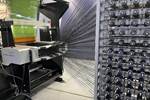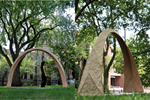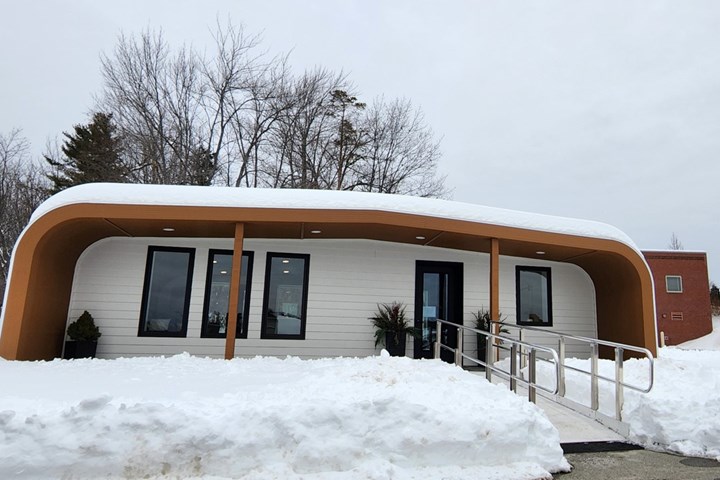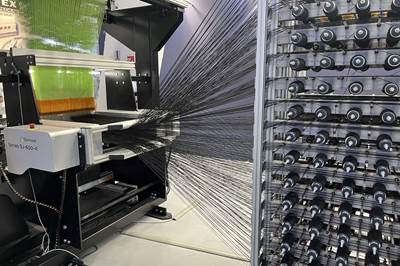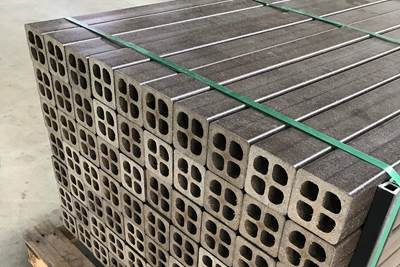UMaine BioHome3D meets sustainability, strength and durability goals
Data collected from one year of outdoor testing reasserts the 3D-printed, bio-based structure’s viability to address housing challenges, sets the stage for future development.
The University of Maine (Orono, U.S.) is celebrating the 1-year anniversary since its development of BioHome3D, said to be the first 100% bio-based 3D-printed home in the world. Data collected after 1 year of outdoor testing has proven its sustainability, strength and overall viability for use to address the growing housing challenge.
BioHome3D is a 600-square-foot home that was designed to meet Maine State Affordable Housing requirements. Printed at the University of Maine’s Advanced Structures and Composites Center (ASCC), it was created entirely with wood residuals, bio-resins and wood fiber insulation. Due to its renewable materials, the home, which includes one bedroom and one
bathroom, is fully recyclable and acts as a carbon sink.
During its inaugural year, BioHome3D endured one of Maine’s most volatile weather years, with sensors reporting temperatures from 1°F to 105°F, extreme wind storms that caused blackouts throughout the state and a number of snowstorms. It performed very well under rain, snow,
temperature cycling and hail. It was designed in accordance with ASCE 7 loading, and meets the design requirements of the International Code Council (ICC) code.
“The data collected over a year of outdoor exposure in Maine has proved that the technology is sound,” notes ASCC executive director Habib Dagher. “Now, our focus is to scale up the production process. With the Factory of the Future, our goal is to be able to produce one of these 600-square-foot homes every 48 hours.”
The ASCC will break ground on the Green Engineering and Materials (GEM) Factory of the Future in August 2024 and is slated to be completed in 2026. It will feature Industry 4.0, as well as AI-enabled, large-scale additive, subtractive and digital hybrid manufacturing technologies developed by UMaine and its federal, national laboratory and industry partners over the past 10 years. It will rely on new collaborative robotics and closed-loop advanced manufacturing equipment and processes, as well as use the new generations of bio-based material systems. It will also provide discovery-driven learning opportunities for the future workforce.
At the start of construction for BioHome3D, the material was printing at a deposition rate of 20 pounds/hour. Over time, production speeds have increased with improvements to the printer to nearly 500 pounds/hour. The focus on scaling up production looks to continue to drive costs of materials and manufacturing down to be competitive or less expensive than traditional
stick-built homes.
With the new manufacturing facility, advancements in production speed, and a partnership with Penquis, ASCC is finalizing plans to print the world’s first bio-based 3D-printed neighborhood. It will feature nine homes with the BioHome3D technology located in the Greater Bangor area, providing housing for individuals experiencing or at risk of homelessness. A new study reports
that nearly 80,000 homes are needed in Maine to fix the deficit and meet demand for affordable housing by 2030, which BioHome3D can help address.
By using locally produced wood residuals, Biohome3D can also support Maine’s forest products industry. The technology was also designed to address labor shortages and supply chain issues that are inhibiting the construction of affordable housing.
BioHome3D was awarded the Aubin AM Case Study Award by the Society of
Manufacturing Engineers and the Combined Strength Award at CAMX 2023.
Designed and produced at UMaine’s ASCC, BioHome3D was primarily funded through the SM2ART program, a U.S. Department of Energy-funded partnership between UMaine and Oak Ridge National Laboratory Manufacturing Demonstration Facility.
Related Content
One-piece, one-shot, 17-meter wing spar for high-rate aircraft manufacture
GKN Aerospace has spent the last five years developing materials strategies and resin transfer molding (RTM) for an aircraft trailing edge wing spar for the Airbus Wing of Tomorrow program.
Read MoreA new era for ceramic matrix composites
CMC is expanding, with new fiber production in Europe, faster processes and higher temperature materials enabling applications for industry, hypersonics and New Space.
Read MoreComposite rebar for future infrastructure
GFRP eliminates risk of corrosion and increases durability fourfold for reinforced concrete that meets future demands as traffic, urbanization and extreme weather increase.
Read MorePlant tour: Spirit AeroSystems, Belfast, Northern Ireland, U.K.
Purpose-built facility employs resin transfer infusion (RTI) and assembly technology to manufacture today’s composite A220 wings, and prepares for future new programs and production ramp-ups.
Read MoreRead Next
Optima 3D demonstrates new 3D weaving technology for ASCC
U.K. company will install compact system with innovative shuttle and digital twin capability for soft and hard composite structures at University of Maine’s new textile lab.
Read MoreBio-based composite construction elements to combat climate change
Neste, LyondellBasell, Biofibre and Naftex cooperate to develop construction components made of bio-based plastics reinforced with natural fiber that can enable the storing of carbon for years or even decades.
Read MoreDumoLab's biodegradable arch enables biocomposite concrete alternatives
Terrene 3.0 is a compression-dominant arch developed as a multidisciplinary research project composed of natural fiber-reinforced sand and other biomaterials that delivers eco-friendly, less energy-intensive building methods.
Read More

